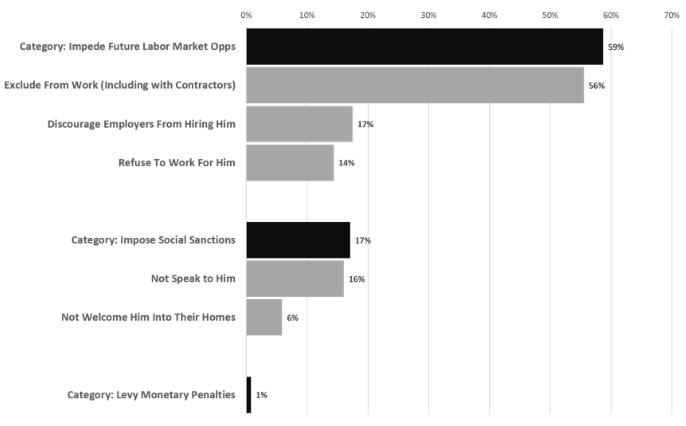A Supply Side Rationale for Wage Floors in Agricultural Labor Markets

Photo Credit: SB Stock | Adobe Stock
In many rural settings, from Malawi to India, farms hire casual wage laborers in active rural labor markets. However, existing research suggests that daily wage rates can be set too high for employers to hire all workers who want jobs, resulting in involuntary unemployment. This inefficiency may misallocate labor and lower agricultural output. Researchers conducted an evaluation in Odisha, India to test whether workers prefer not to take up jobs at lower wages, even in times of high unemployment, due to social pressures from other workers. The study finds that unemployed workers would like to find work, and prefer to do so even at wages below the prevailing wage rather than remain unemployed. However, they rarely do so when this choice is observable to other workers. In contrast, social observability does not affect labor supply at the prevailing wage. The study also finds, using surveys and a lab-in-the- field exercise, that social pressure is a plausible mechanism for sustaining wage rates at above-equilibrium levels.
Policy Issue
Do social norms influence the wage that daily farm laborers will accept, even in the absence of formal institutions that coordinate collective action, such as labor unions? And if so, does this generate higher rates of involuntary unemployment? What are the implications for workers’ overall welfare?
Enforcing collective action through social norms and social sanctions may be particularly relevant in poor countries, where local social networks are often key in risk sharing and information diffusion. These high levels of social capital make it more likely that norms arise and can be sustained effectively through the threat of sanctions, for example, by withholding information about job opportunities.
Context of Evaluation
Hundreds of millions of workers in India participate in casual daily labor markets; these markets provide 98% of the country’s hired agricultural labor. In Odisha, over half of survey respondents list daily-wage agricultural labor as their main occupation. This work is informal, and verbal contracts are organized between laborers and employers without formal labor organizations. However, even with this flexibility, there is still high unemployment in the agricultural lean season; on average, workers report not being able to find work on 12 out of 30 days. There is a clear prevailing wage for agricultural labor a) with little variation between laborers of the same gender in the same village for the same task, b) and almost all workers agree on the wage rate. These indicate that strict norms around the prevailing wage may contribute to this degree of involuntary unemployment.
Details of the Intervention
Researchers partnered with agricultural employers in Odisha, India to examine whether a worker’s decision to accept jobs at different wages would be affected by social observability (and therefore other workers’ knowledge about the participant’s choice). The study takes place across 183 villages and includes a total of 502 workers. In each study village, researchers partnered with a local landowner during non-peak times in the agricultural cycle (not during transplanting or harvest periods for rice). Researchers randomly varied whether the employer offered a day of work at the prevailing wage, or at 10% below this wage. They also varied whether the job offer was made outside or inside the worker’s home, to measure how the public nature of the job offer affected the participant’s response. Importantly, workers in the study made decisions about real job opportunities, often involving work for a familiar farmer from their village.
Researchers also used workers’ responses to hypothetical or anonymous scenarios (via survey questions and “lab-in-the-field” exercises) to ethically test whether workers would sanction other laborers in scenarios in which they had accepted employment below the prevailing wage.
Results and Policy Lessons
Social norms prevent laborers from accepting employment opportunities below the prevailing wage level: 26 percent of workers take the job at the prevailing wage, and the observability of the job offer makes no discernible difference in their rate of acceptance. In addition, workers prefer to work even at wages below the prevailing wage, rather than to remain unemployed: 18 percent of workers accept a job at 10 percent below the prevailing wage in private. However, workers rarely take the job at this lower wage rate when the choice is observable to other workers – workers’ willingness to accept lower wages decreases by 13.6 percentage points (a 78 percent decrease) in public. This suggests that social norms suppress workers’ ability to take up jobs that they would privately prefer to take.
Workers’ decision not to take the job at below the prevailing wage in public, even when they are otherwise likely to remain unemployed for the day, has a large impact on their foregone earnings. Workers’ weekly wage earnings decrease by 26-49 percent when lower wage offers are made in public rather than private. These results are strongest in villages with the highest levels of involuntary unemployment.
Workers indeed express disapproval of laborers who accept wage cuts: Survey evidence suggests that those who accept lower wages would, for example, not be referred by their fellow laborers for future work opportunities.
In a supplementary lab-in-the-field exercise, each participant is given anonymized information about whether another worker in the same village took a job, either at the prevailing wage or below the prevailing wage. Both start with an endowment of Rs. 100. The participant is then asked if he wishes to give away money from his own endowment to reduce the amount of endowment that this other individual receives. Researchers find that workers are willing to reduce the endowment of those who accept a wage cut 37 percent of the time, at the cost of giving up some of their own endowment. This enables the researchers to uncover the presence of social sanctions while maintaining anonymity about participants’ choices.

Figure source: https://voxdev.org/topic/labour-markets-migration/scabs-social-suppression-labour-supply
The implication of these findings is that workers who want to accept lower wage jobs will not do due to concern that they will face sanctions from other workers. Consequently, these workers choose to remain unemployed instead.
The study shows that the potential for social sanctions helps sustain wage norms (i.e. wage floors), even in the absence of formal collective action through unions, and these norms can decrease earnings and increase involuntary unemployment levels. In addition, the authors show suggestive evidence that collective action can affect aggregate economic outcomes in a meaningful way. They use household survey data from across the whole country to show that areas expected to have lower social cohesion (where collective action is more difficult to sustain) show less ability to sustain higher wages from a positive productivity shock when productivity later reverts to average or below-average levels.
In an article on VoxDev, the authors answer whether workers gain from this behavior by explaining, “Social norms in the labor market might help workers coordinate to exert greater market power, extracting surplus from employers. On the other hand, wage floors may increase wages for the average worker, at the cost of increased involuntary unemployment. We conduct a back-of-the-envelope calculation of gains to worker surplus following Lee and Saez (2012). We find that, under admittedly strong assumptions, the market wage without the wage floor would be 7% lower, and, correspondingly, employment would be 7% higher. Workers benefit from the wage floor: workers’ surplus is 64% higher relative to the competitive equilibrium. Future research can explore collective behavior among employers, and the distribution of surpluses among workers, to validate our assumptions.”
The study augments existing evidence documenting informally collusive behavior in varied contexts, and points to future opportunities to account for this norm in creating policies that improve economic outcomes and overall welfare. For example, the findings could imply that targeting wage subsidies towards agricultural work (rather than public works programs for non- agricultural work) may be a more cost-effective way to boost employment and productivity, without breaking the village wage norm or reducing worker earnings.
This evaluation summary was originally posted on the ATAI website.

